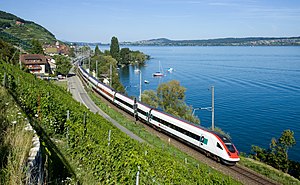| SBB RABDe 500 | |
|---|---|
 Two RABDe trainsets passing Lake Biel in 2011 | |
 Inside view of the ICN second class corridor | |
| In service | 2000–present |
| Manufacturer | Adtranz |
| Number built | 44 |
| Number in service | 44 |
| Formation | 7 cars |
| Fleet numbers | 500 000–500 043 |
| Capacity | 470 |
| Owners | Swiss Federal Railways |
| Lines served | |
| Specifications | |
| Train length | 188,800 mm (619 ft 5 in) |
| Maximum speed | 200 km/h (125 mph) |
| Weight | 355 t (349 long tons; 391 short tons) |
| Power output | 5,200 kW (7,000 hp) |
| Electric system(s) | 15 kV 16.7 Hz AC |
| Notes/references | |
| [1] | |

The SBB RABDe 500, also known as the ICN,[a] is a Swiss high speed passenger train which was introduced in 2000, in time for Expo.02 held in western Switzerland in 2002. Its maximum speed is 200 km/h (125 mph), and it employs tilting technology, which allows it to travel through curvy routes faster than non-tilting trains. The train sets were a joint development by Bombardier, Swiss Federal Railways and Alstom, with an aerodynamic body designed by Pininfarina, bogies and tilting mechanism designed by the then SIG, Schweizerische Industrie Gesellschaft.
Forty-four RABDe 500 trains with a total of 308 coaches were delivered to SBB-CFF-FFS between 1999 and 2005. The RABDe 500 often run with two complete compositions, each with seven carriages and a seating capacity of 480,[3] both including a dining car. The outer four of the seven carriages are second class.
- ^ Haydock, David (2016). Swiss railways: locomotives, multiple units and trams (4th ed.). Sheffield: Platform 5. p. 64. ISBN 978-1-909431-23-2.
- ^ Cite error: The named reference
news.chwas invoked but never defined (see the help page). - ^ "Swiss Tilting Trains - Railwey Technology". Railway Technology. 28 January 1999. Retrieved 13 November 2023.
Cite error: There are <ref group=lower-alpha> tags or {{efn}} templates on this page, but the references will not show without a {{reflist|group=lower-alpha}} template or {{notelist}} template (see the help page).